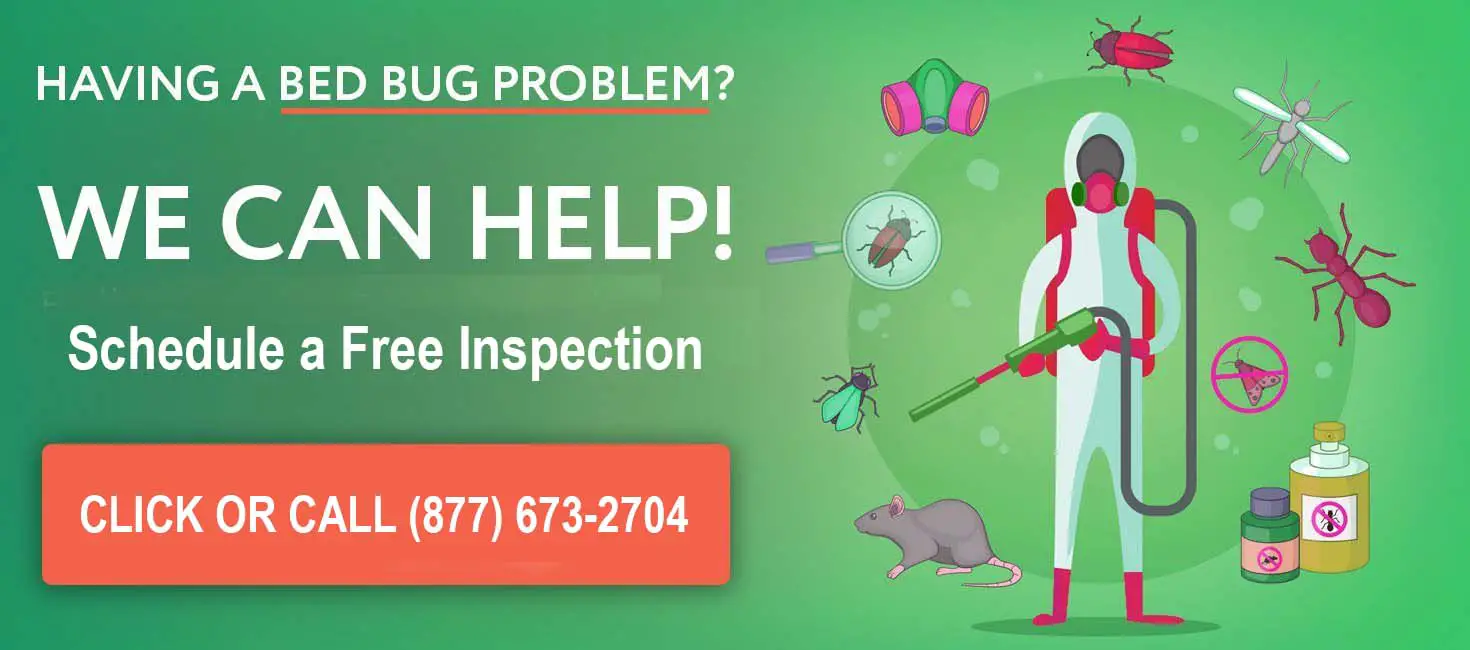"Bed bugs live for approximately 10 months and move through a life cycle from egg to adult. Infestations usually start with a female bed bug who would bite the host for blood upon arrival in the bed, and then for another "meal 2 weeks later. At that point, she would lay eggs in the home at a rate of 3 per day. It takes 2 weeks for an egg to hatch. The just born nymph looks for food right away and becomes an adult bed bug in 4 months. The speed of reproduction and total life span is affected by room temperature and what is described assumes a room at 68F (20C). The adult bed bug lives for approximately 10-months, but can live without feeding up to a year if you decide to move to another room. A typical infestation has between 4 and 500 bed bugs"
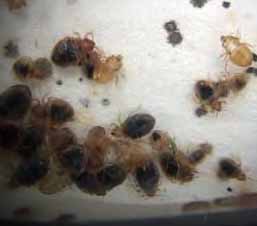 Picture Shows Image of a Bed Bug at Different Life Stages
Picture Shows Image of a Bed Bug at Different Life Stagestable of contents
Overview
Bed bugs have three life stages and vary in appearance depending on the stage. They start in an egg that is 1mm in length and then are born into 5 baby (also called juvenile or nymph) stages (1.5mm to 4.5mm in length). This is followed by adulthood where the insect grows to approximately 3/8" (5.5mm long).
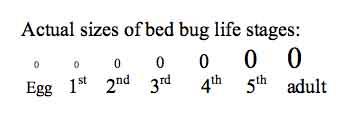 Actual Bed Bug Size at Each Life Stage
Actual Bed Bug Size at Each Life StageA picture of bed bug at each stage of development is depicted below.
Pictures are also provided to help distinguish bedbugs from other insects which are similar in appearance.
What do Bed Bugs Look Like?
Bed bugs move through 5 instars or stages on their way to adulthood. After hatching they are about the size of a poppy seed. To pass from stage to stage, the need to take in a blood meal. Bed bugs have a stylet on their head which is used to puncture the skin of their human host. Photos and descriptions of each instar can be found below.
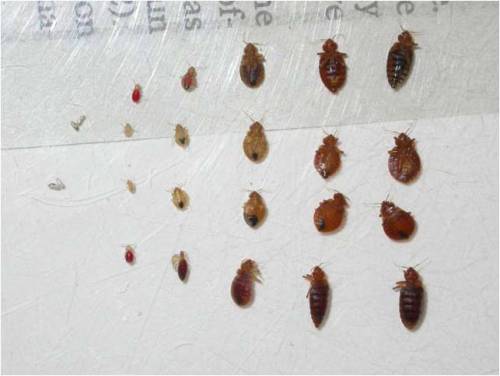 Pictures of Bed Bugs at Each Life stage, From Baby to Adult Bed Bugs
Pictures of Bed Bugs at Each Life stage, From Baby to Adult Bed BugsIn favorable conditions it takes between 4 weeks to 5 weeks to go from a hatched nymph to adult (at 83 to 90 degrees F). A nymph or baby bed bugs can live for 3 to 4 months without a blood meal, adults can live just over a year.
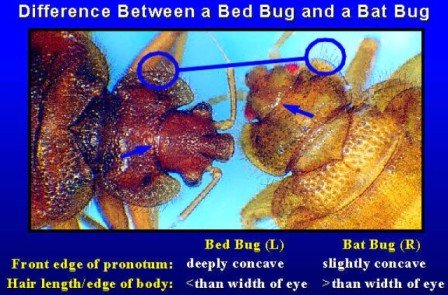 Source: University of Nebraska-Lincoln
Source: University of Nebraska-Lincoln
Bed Bug Eggs
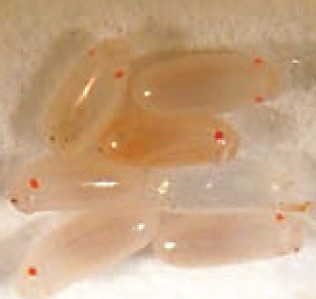 Bed bug eggs are about the size of a pin head. They are pearl white in color and have a reddish eye spot if the eggs are 5 days or older.
Bed bug eggs are about the size of a pin head. They are pearl white in color and have a reddish eye spot if the eggs are 5 days or older.
Eggs are white in color and slightly round and are 1mm long. Over their 10 month life span a female will lay 200 - 500 eggs in groups of 1 to 5 eggs per day and appear to be glued onto each surface. Eggs are attached with a substance that firmly adheres them to the surface. This makes picking them up with a vacuum impossible. One approach is to pick them up with the sticky side of tape.
Other options include: heat, such as from a hand steamer, and sprays that are labeled to kill bed bug eggs such as Bedlam.
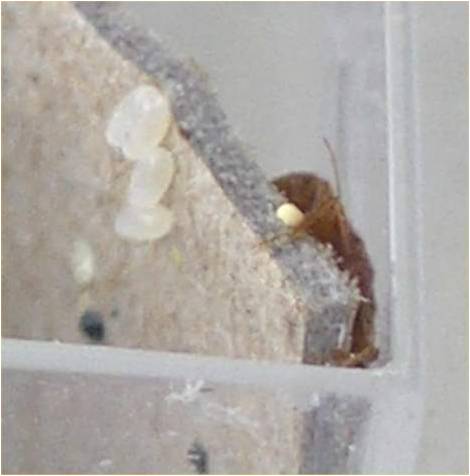 Picture of Bed Bugs Eggs Attached to a Surface
Picture of Bed Bugs Eggs Attached to a Surface
baby bed bugs(nymphs)
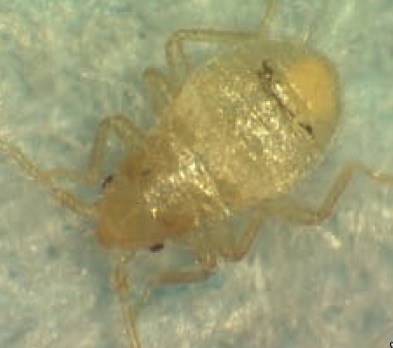 Bed Bug Nymphs are Straw color. The first Instar Nymph is small and the most difficult to see. After feeding they turn reddish in color making them easier to spot.
Bed Bug Nymphs are Straw color. The first Instar Nymph is small and the most difficult to see. After feeding they turn reddish in color making them easier to spot.
Bed bugs move through 5 nymph phases (baby bed bugs) before reaching adulthood. The insects need to drink a blood meal to move from phase to phase. A nymph can live for 3 to 4 months while they wait for a human or animal to feed on.
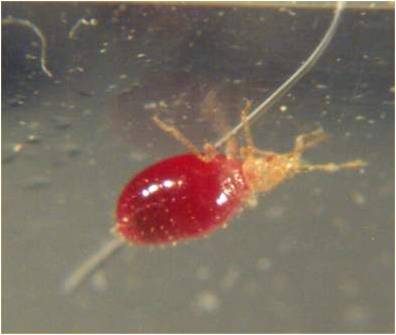 Bed Bug Nymph After Feeding
Bed Bug Nymph After Feeding
adult bed bugs
An adult bed bug is brown until it feeds on a human or animal host. After feeding the adult changes color into a dull red/dark brown. Bedbugs are 3/16 of an inch in length, about the size of an apple seed (longer after a blood meal as depicted below). Before feeding they can appear to be a flat disc while after feeding the body engorges and becomes larger as if it was a balloon.
Bed Bugs have what are called Vestigial wings (not fully developed), but can't fly. The bugs are covered by thin golden hair. Male bed bugs have a pointed abdomen while females have a rounded abdomen. An adult female bed bug can live as long as 277 days without feeding.
Their small and flat profile makes it easy for them to hide in small space and fit through cracks in the walls and floors. Bed bugs are so small, that they have been found inside electronics, and between the glass and window frames. This is why when treating bed bugs, every inch of a room, including looking behind bed frames and pictures, is a required part of treatment.
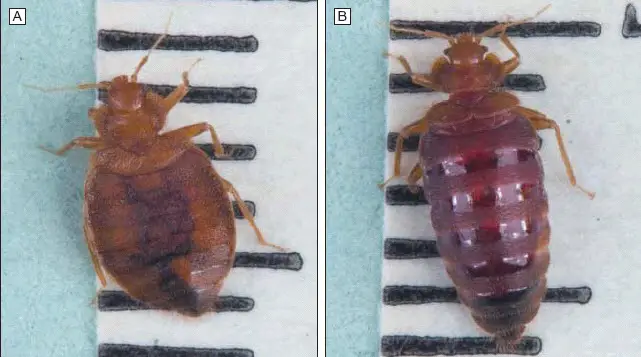 Adult bed bugs are flat and approximately 1/4 inch in length. Their size will grow by approximately 1/3 after feeding as depicted on the right.
Adult bed bugs are flat and approximately 1/4 inch in length. Their size will grow by approximately 1/3 after feeding as depicted on the right.
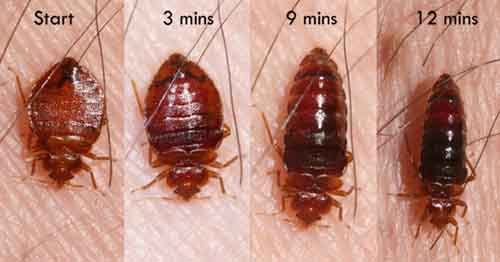 Bed Bugs Change Color & Shape While Feeding on Host - Picture from Whitney Cranshaw, Colorado State U.
Bed Bugs Change Color & Shape While Feeding on Host - Picture from Whitney Cranshaw, Colorado State U.
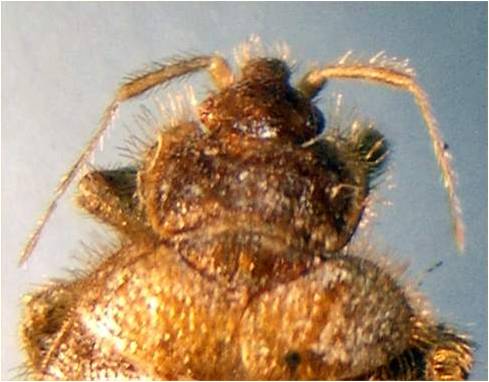 Up Close Dorsal(Head) View of Adult Bed Bug
Up Close Dorsal(Head) View of Adult Bed Bug
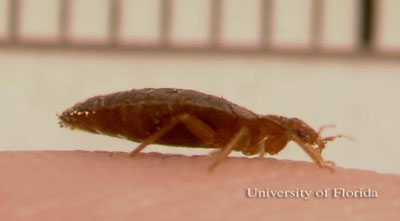 Picture of Bed Bugs - Side View
Picture of Bed Bugs - Side View Source: University of Florida
Bedbug Life Cycle Pictures
This page features pictures and videos of bed bugs at each stage of their life cycle. A bedbugs life starts with the egg. After hatching they pass through 5 nymph stages (called Instars), culminating in adulthood. They are referred to as nymphs until they reach adulthood.
A bed bug needs to feed at least once to move from stage to stage. Under ideal conditions/temperature, a bed bug will live for approximately 10 months. Each stage lasts from 4 to 24 days depending on the temperature and access to food. If all things are perfect the lifecycle takes about 5 weeks.
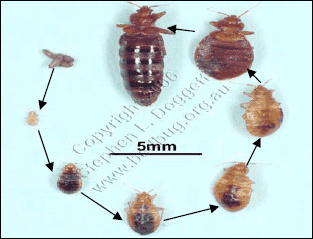 Each Stage of a Bed Bugs Life in Chronological Order
Each Stage of a Bed Bugs Life in Chronological OrderSource: Department of Medical Entomology, ICPMR, Westmead Hospital
Life Cycle Chart
The life cycle chart below shows how the appearance of a bed bug changes after a blood meal. Bed bugs move through 5 "molts" before becoming adults and need to feed prior to each molt. They shed skin after each molt, leaving behind another sign of an infestation.
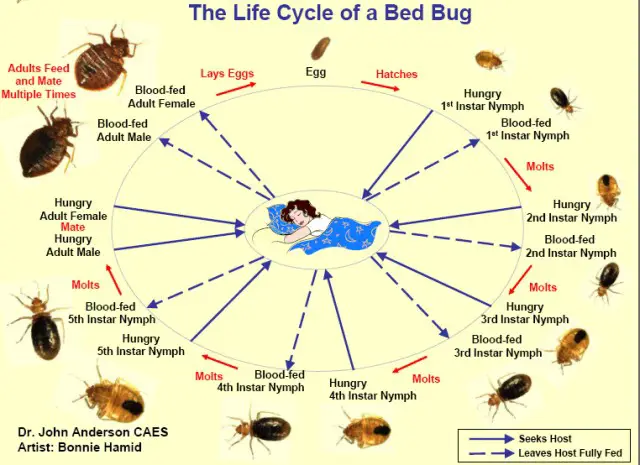 Bed bugs change in appearance from egg to nymph (young bedbug) to adult. Bed bugs can live up to 316 days. The time from nymph to adult is 5 to 8 weeks. Eggs take 10 days to hatch.
Bed bugs change in appearance from egg to nymph (young bedbug) to adult. Bed bugs can live up to 316 days. The time from nymph to adult is 5 to 8 weeks. Eggs take 10 days to hatch.Common Signs of Infestations
Signs of bed bugs include fecal markings on the bed, bed bug bites, and seeing the bugs themselves. A thorough inspection of all tight spaces in a room are required to identify all of the places bed bug hide.
Bed bug infestations occur near where there is a sleeping or still human host, which is why the bedroom is the first place to look. The den or areas where you entertain are a secondary area for bed bug problems, with insects entering the home on the clothes of visitors.
If you have a suspected bed bug infestation, here are a few things you can do to confirm that you have a bedbug problem.
- Identify bed bugs by capturing and examining a bed bug.
Best approach for verification is to show an insect to an exterminator, local cooperative extension or mail a sample insect to the Cornell Diagnostic Laboratory. See pictures below of bedbugs at every life stage (from egg to adult). - Bed bug bites: based on the location and pattern of the bites, it could indicate the presence of these insects. Bed bugs tend to bite exposed skin areas during sleep. Bites concentrated in other areas (lower legs or chest) indicate other insects or an allergy respectively.
- Check Bed bug hiding places and look for signs of bed bugs on furniture or near mattress seams. Signs include brown fecal stains or blood stains.
Bedbug Identification
If you need help to identify bed bugs in your home in order to confirm that you have a bed bug problem, you can mail a sample with a small fee to the Cornell University Insect Diagnostic Laboratory.
Another approach is to contact an exterminator through the Home Advisor network (or call 866-214-8380) who can confirm that you have an infestation. If you can capture an insect in a plastic pill jar or Ziploc bag.
Bed Bug Behavior and Identification Video
National Geographic put together a helpful video on bed bugs and their behavior. This is a good first step in learning how to identify bed bugs.
Where do Infestations Come From? Common Causes and Solutions
Bed bugs in college dorms or picking them up when traveling is a common problem. Given the transient nature of these institutions, people are constantly picking up and dropping off bed bugs. They can be transported home in the seams of luggage or a backpack as indicated below:
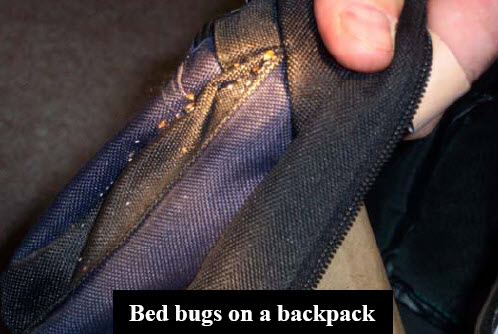 Bed Bugs in College Dorm - On Backpack
Bed Bugs in College Dorm - On Backpack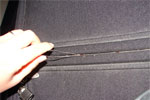 Bed Bugs Hiding in Luggage Seam
Bed Bugs Hiding in Luggage SeamTo
protect luggage from bed bugs, be sure to keep it off the floor when
entering a hotel room. Hang clothes on the shower rack, not in
the closet. Keep all items off the bed, the number 1 hiding place
for bed bugs. Consider Bed Bug Proof Luggage which usually has a built in heating element to kill any bed bugs before you return home.
How Often Do Bed Bugs Feed?
Adult bed bugs will feed every 3 to 7 days depending on room temperature. Females cannot produce eggs without feeding.
Survival and temperature
Bed bugs are killed in extreme heat and cold:
- Heat: Killed at 120°F, or long exposure to 113°F
- Cold: Can survive for a short time at 5°F, and can last for days at 32°F
Bed bugs can live for about a year without a blood meal.
Ask a Question or Share Your Bed Bug Experience With Others
Do you have a question or great story about bed bugs? Share it!
What Other Visitors Have Said About Bed Bugs
Click below to see contributions from other visitors to this page...
Bed Bugs at Night Not rated yet
I am 11. I keep seeing them at night when I'm on my phone at night. I'm scared. Do they get in my skin will I die, please help.
Editor Reply Bed Bugs …
